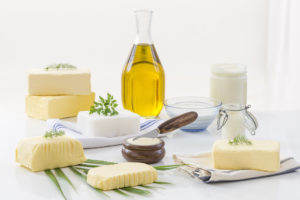Research shows that consumers are looking for quality over quantity, and the addition of dairy fats in confectionery allows for indulgent mouthfeel experiences compared to cheaper vegetable fats.
Today, consumers are becoming increasingly mindful of the food they eat and where the ingredients come from. They seek innovative, sensory experiences while clean label, plant-based, nutritional profile and sustainability continue to influence purchasing decisions. This is also true for both oils and fats, which play a huge role in the texture and experiences created when eating confectionery and bakery products.
Tim Van de gehuchte, International Sales & Marketing Manager at Meurens Natural says: “Clean label, over the last decade, has been one of the biggest trends within the food and beverage industry, and it’s always transforming. A couple of years ago, the idea of clean label was for customers to understand what was on the label and removing chemical additives – now it’s also about the environment, carbon footprint and transparency of where the ingredients are sourced.
“Because of COVID, people realise that they must start living a healthier life, and a healthier life starts by controlling what you eat. With more people interested in food and nutrition, and living in the ‘Information Age’, we can access more information and become more educated on the ingredients we see. Thanks to the internet, this information is instant too.”
Because of this demand, more specialised nutritional research has been undertaken, which is giving us a better view on what we eat, how much we must eat and what the health consequences are of certain types of food we consume.

“Healthcare costs are increasing substantially, so because of that, people are looking at what can be done to prevent disease, rather than to cure it with pharmaceutical medicines. It’s better that you have an immune system that is working well, than an immune system that is already compromised to begin with, because of poor nutritional health,” explains Van de gehuchte.
Hendrik Schulze, Key Account Manager Dairy Products & Ingredients says: “While a few years ago there was a tendency to replace the milk fats contained in many products such as chocolate bars and ice cream with cheaper vegetable fats, today we see a somewhat different development. It is no longer primarily a matter of making the recipes of confectionery as cheap as possible at any price, but taste and enjoyment have taken on a new significance in the consciousness of consumers.
“Taste and enjoyment have taken on a new significance in the consciousness of consumers”
“Consumers prefer to consume a little less, but consciously and of high quality. In addition, criteria such as sustainable cultivation, regionality and quality of raw materials are currently much more in focus. Some vegetable fats are now being judged rather critically. Milk fats, on the other hand, which are clean label products by nature, serve all the above-mentioned trends and are therefore a sought-after raw material for high-quality confectionery, especially in the premium segment,” he explains.
Milk fats in particular primarily ensure a good taste in the end product, of course. Many flavours are also fat-soluble and only develop their full aroma in combination with fat. In addition, they also have a major influence on certain properties such as the melting behaviour of chocolate and chocolate bars or the mouthfeel when consumed. While some vegetable fats with higher melting points, for example, leave an unpleasant greasy film on the tongue, the melting point of milk fats is below human body temperature, so that chocolate, for example, melts pleasantly in the mouth.
To help food manufacturers meet this demand, Cargill has launched CremoFLEX, a customisable range of premium filling fats.CremoFLEX filling fats can be tailored to suit different specific formulation needs, including the use of RSPO certified palm solutions, and can be used in several applications like filled biscuits and sandwich cookies, wafers, filled chocolates tablets and pralines.
The conscientious consumer of today expects innovative sensory experiences, while challenges such as clean label, nutritional profile and sustainability are increasingly influencing their purchasing decisions. To help bakery and confectionery producers solve these major challenges, Cargill recently launched CremoFLEX, its latest range of premium filling fats across Europe.
CremoFLEX filling fats can be tailored to suit different specific formulation needs, including the use of RSPO certified palm solutions, and can be used in several applications like filled biscuits and sandwich cookies, wafers, filled chocolates tablets and pralines. At Cargill’s European food innovation center in Vilvoorde (Belgium), a dedicated team of food scientists has been working to develop this broad range of filling fats that can be tailored to meet individual customer processing and application needs. Cargill says it is also investing significantly into the production facility in Hamburg (Germany) to support this new technology.
Move to more sustainably sourced ingredients
Sustainability is the dominant theme. Today’s informed consumers attach importance to sustainable production and transparency in the ingredients used and their origin. Of course, this also has an influence on the development of production processes and facilities. Resource-saving, efficient plant technology, the recovery of process heat and recycled water, for example, have long since become standard.
Schulze adds: “This is also reflected on the raw material side in the cultivation of vegetable fats and in milk production. As far as possible, vegetable fats should come from certified cultivation. In milk production, there are many projects and ideas for improving the climate balance of milk; we are also in constant dialogue with our milk producers and have launched corresponding pilot projects.”
In addition, regionality has become much more relevant; procuring raw materials as far as possible in the immediate vicinity of the production sites reduces CO2 consumption because it eliminates long transport routes. In any case, oils and fats will continue to be indispensable for food production in the future, if for no other reason than that they are indispensable for the human body. It’s just that they will be produced and used more consciously.
World trends
New research from Innova Market Insights shows that consumers want their dairy purchases to satisfy multiple concerns and cravings. Attitudes and opinions can vary widely from one category to the other. For example, milk and yogurt purchasing is driven largely by everyday nutrition needs.
For milk shoppers, traceability and sustainable farming methods are also increasingly important, while almost half of yogurt consumers prefer products to have some type of extra health benefit. Yet with cheese, messages related to nature and tradition are more likely to turn heads.
“Vegetable fats should come from certified cultivation. In milk production, there are many projects and ideas for improving the climate balance of milk”
The popularity of dairy varies widely in different parts of the world. For example, there is a marked divide between Europe – a region of dairy lovers – and Asia, where there is much less of a tradition of consumption.
Having said that, research also shows that Asians are far more likely than Western consumers to be increasing their dairy intakes (e.g. 42% in China and Vietnam vs. 13-14% in France and Germany). Therefore, while uptake remains lower in Asia, there is hope for wider interest and more mainstream dairy purchasing in the future.
Looking ahead, the global pandemic has intensified consumer interest in naturalness and traceability, and these will be important for dairy innovators going forward. In addition, growing competition from plant-based alternatives increase pressure on the dairy industry to understand consumers’ needs and target them accordingly.
Tim Van de gehuchte, International Sales & Marketing Manager at Meurens Natural says:

“Refined sugars increase the risk of obesity, type 2 diabetes, cardiovascular disease, and they are in almost all foods. In many cases, we find sugars are added for taste, or for bulk, and this is where alternatives are needed.
We try to contribute to the production of healthier and better-for-you foods, by supplying the industry with non-refined products. We produce non refined, organic, and natural cereal, which is also a completely environmentally friendly and 100% natural production process. This means we don’t use any chemical additives, as they do in the sugar or glucose manufacturing industry,” he explains.
By using a natural process, Meurens Natural preserve a maximum of features and properties of our raw materials, allowing their customers to make delicious and authentic products. By just adding water to the bases, you can make a pure oat drink, free from any additives. Customers can then apply their own formulation, adding the ingredients of their choice, to give it the desired taste and texture. These bases are also particularly suitable for making plant-based yoghurts, ice creams or desserts. Their bases also save storage space with their concentrated format and provide great flexibility of use over time as their shelf life extends from three to twelve months depending on the products.
The enzymatic hydrolysis is used to create a separation, and we use a mechanical filtration which allows us to keep the full spectrum of nutritional value of the cereal that we have processed. This way, you have the original taste, the colour, and the original mineral content is all preserved. The ingredients have multiple functionalities, which means it limits the amount of ingredients needed – making the product as clean label as possible.”
Hendrik Schulze, Key Account Manager Dairy Products & Ingredients for Uelzena says:

“As a supplier of milk-based ingredients to the confectionery and food industry, we actually hardly felt any impact on sales of our milk fats to these customer groups. However, at least in the first phase of the pandemic, there was a certain amount of uncertainty in the market and among our customers, which was characterised by cautious trading; requirements tended to be covered for shorter periods than usual in order to be able to react quickly to any changes in consumer purchasing behaviour. However, since the consumption of confectionery and the corresponding demand in the food retail sector tended to increase during the pandemic, things returned to normal relatively quickly. On the one hand, there was a trend among consumers to eat more consciously and healthily, but on the other hand, there was also the need to treat oneself, to comfort oneself, to reward oneself … Apart from confectionery, there was generally a strong increase in sales in food retailing during the lockdown phases; for us, for example, this led to a significantly higher demand for clarified butter in cups and 250 g butter chunks on the part of our retail customers.
From our point of view, this increase is mainly due to a greater demand for drinking milk, fresh milk products, cream and butter in food retail. Many adults were at home in the home office and the children in home schooling, and in private households there was much more home cooking and baking than usual. In the uncertain phase at the beginning of the pandemic, there were veritable hoarding purchases of food. This led to increased production of dairy products and, of course, a correspondingly greater demand for raw milk.”
Stefan Lehner, Senior Key Account Manager for Cargill’s edible oils business in Europe says:

“The CremoFLEX product range helps to optimize production processes without negatively impacting the quality, taste and appearance of their products, at the same time maintaining the brand loyalty of their consumers.
Think about mouthfeel and melting profile. This unique offering enables food manufacturers to achieve tasty yet healthier and cleaner products for mindful snackers, whilst also meeting European food regulatory standards”, Lehner adds. Depending on customers wishes, the CremoFLEX range now offers the ability to develop indulgent products with lowered saturated fatty acid (SAFA) by comparison to conventional solutions and provides clean label non-hydrogenated products. The new CremoFLEX range will initially consist of three product types:
CremoFLEX S: Thanks to the specific crystal form of these fats, they give a clean and cool melting and their SAFA levels varying from 50%-65%.
CremoFLEX F: These products are bloom retarding in chocolate applications due to their unique distribution of triglycerides. By using the correct combination with other vegetable oils and specific processing technologies they give excellent sensory and physical properties.
CremoFLEX L: The combination of non-lauric base stocks with modern processing creates stable textures during shelf life. Their SAFA levels vary from 35% to 55% compared to traditional filling fats, providing the possibility to create new products with reduced SAFA levels.”
To stay up to date on the latest, trends, innovations, people news and company updates within the global confectionery market please register to receive our newsletter here
Media contact
Kiran Grewal
Editor, International Confectionery
Tel: +44 (0) 1622 823 922
Email: [email protected]









